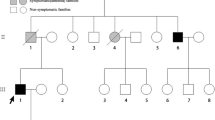Abstract
Although the majority of renal amyloidosis is caused by either acquired monoclonal immunoglobulin light-chain amyloidosis or reactive systemic amyloid A, some cases are caused by hereditary amyloidosis. Apolipoprotein A-II (apoAII) amyloidosis is a rare form of hereditary amyloidosis and cannot be diagnosed by a routine examination. Thus, the prevalence and etiology of apoAII amyloidosis are uncertain. In humans, a genetic mutation in the stop codon of apoAII is considered to be a cause of amyloid fibril formation. We report on a 68-year-old man who presented with proteinuria by apoAII amyloidosis without family history. His proteinuria gradually increased to 6 g/day within 1 year. A renal biopsy showed amyloid deposition in the glomeruli, however, acquired monoclonal immunoglobulin light-chain amyloidosis and reactive systemic amyloid A were ruled out. Immunohistochemistry revealed apoAII deposition in the glomeruli, but DNA sequencing did not identify any genetic mutation in the coding sequence of apoAII. Here, we report a case of apoAII amyloidosis without a genetic mutation in the coding sequence and discuss the etiology of apoAII amyloidosis.



Similar content being viewed by others
References
Lachmann HJ, Booth DR, Booth SE, Bybee A, Gilbertson JA, Gillmore JD, et al. Misdiagnosis of hereditary amyloidosis as AL (primary) amyloidosis. N Engl J Med. 2002;346:1786–91.
Dember LM. Amyloidosis-associated kidney disease. J Am Soc Nephrol. 2006;17:3458–71.
Murphy CL, Wang S, Kestler D, Larsen C, Benson D, Weiss DT, et al. Leukocyte chemotactic factor 2 (LECT2)-associated renal amyloidosis: a case series. Am J Kidney Dis. 2010;56:1100–7.
Ueda M, Misumi Y, Mizuguchi M, Nakamura M, Yamashita T, Sekijima Y, et al. SELDI-TOF mass spectrometry evaluation of variant transthyretins for diagnosis and pathogenesis of familial amyloidotic polyneuropathy. Clin Chem. 2009;55:1223–7.
von Hutten H, Mihatsch M, Lobeck H, Rudolph B, Eriksson M, Röcken C. Prevalence and origin of amyloid in kidney biopsies. Am J Surg Pathol. 2009;33:1198–205.
Higuchi K, Yonezu T, Kogishi K, Matsumura A, Takeshita S, Higuchi K, et al. Purification and characterization of a senile amyloid-related antigenic substance (apoSASSAM) from mouse serum apoSASSAM is an apoA-II apolipoprotein of mouse high density lipoproteins. J Biol Chem. 1986;261:12834–40.
Higuchi K, Kitagawa K, Naiki H, Hanada K, Hosokawa M, Takeda T. Polymorphism of apolipoprotein A-II (apoA-II) among inbred strains of mice. Relationship between the molecular type of apoA-II and mouse senile amyloidosis. Biochem J. 1991;279:427–33.
Benson MD, Liepnieks JJ, Yazaki M, Yamashita T, Hamidi Asl K, Guenther B, et al. A new human hereditary amyloidosis: the result of a stop-codon mutation in the apolipoprotein AII gene. Genomics. 2001;72:272–7.
Yazaki M, Liepnieks JJ, Barats MS, Cohen AH, Benson MD. Hereditary systemic amyloidosis associated with a new apolipoprotein AII stop codon mutation Stop78Arg. Kidney Int. 2003;64:11–6.
Yazaki M, Liepnieks JJ, Yamashita T, Guenther B, Skinner M, Benson MD. Renal amyloidosis caused by a novel stop-codon mutation in the apolipoprotein A-II gene. Kidney Int. 2001;60:1658–65.
Westermark P, Bergström J, Solomon A, Murphy C, Sletten K. Transthyretin-derived senile systemic amyloidosis: clinicopathologic and structural considerations. Amyloid. 2003;10(Suppl 1):48–54.
Xing Y, Nakamura A, Chiba T, Kogishi K, Matsushita T, Li F, et al. Transmission of mouse senile amyloidosis. Lab Invest. 2001;81:493–9.
Korenaga T, Yan J, Sawashita J, Matsushita T, Naiki H, Hosokawa M, et al. Transmission of amyloidosis in offspring of mice with AApoAII amyloidosis. Am J Pathol. 2006;168:898–906.
Qian J, Yan J, Ge F, Zhang B, Fu X, Tomozawa H et al. Mouse senile amyloid fibrils deposited in skeletal muscle exhibit amyloidosis-enhancing activity. PLoS Pathog. 2010;6:e1000914.
Acknowledgment
We thank Shizuka Fujii for technical assistance.
Conflict of interest
The authors have declared that no conflicts of interest exist.
Author information
Authors and Affiliations
Corresponding author
About this article
Cite this article
Morizane, R., Monkawa, T., Konishi, K. et al. Renal amyloidosis caused by apolipoprotein A-II without a genetic mutation in the coding sequence. Clin Exp Nephrol 15, 774–779 (2011). https://doi.org/10.1007/s10157-011-0483-4
Received:
Accepted:
Published:
Issue Date:
DOI: https://doi.org/10.1007/s10157-011-0483-4




